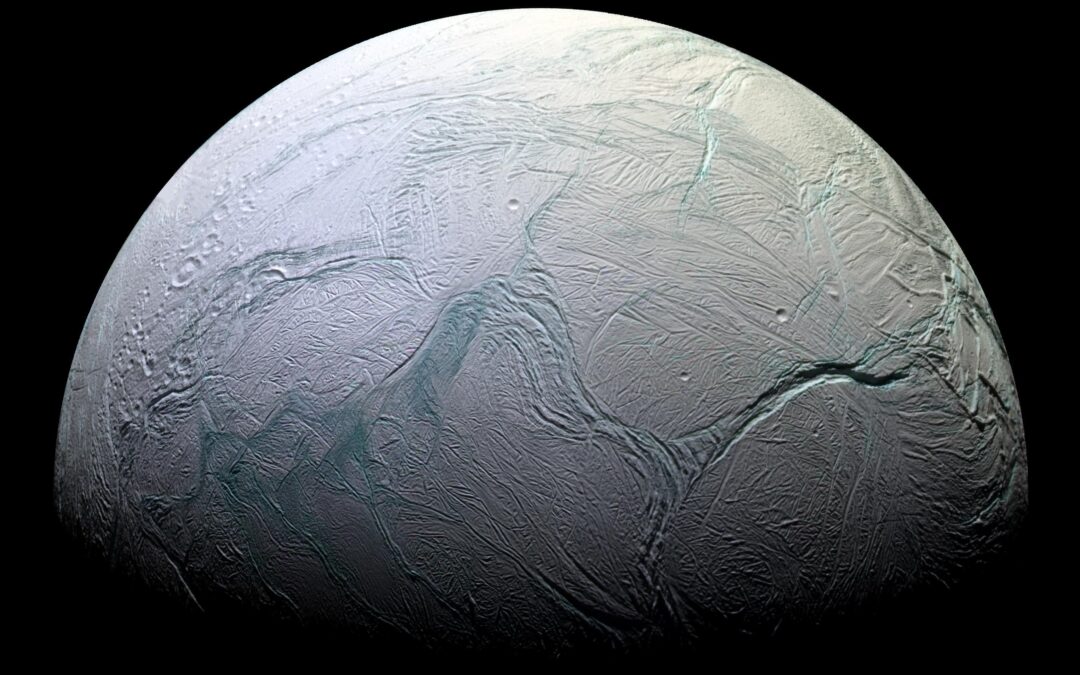Advanced Space doesn’t just have a spacecraft flying at the Moon: we also investigate missions to deep space.
Last year, we conducted a feasibility study for a local non-profit organization (ASTROBi Foundation) that investigated the functions, cost, and complexity of three major components for a low-cost mission to Saturn’s moon Enceladus: (1) the entire trajectory set for a spacecraft to follow, (2) the navigation architecture, including both in-space and ground-based navigation, and (3) a low-cost ground system to support the mission. The mission’s science goal is to determine if biological signatures of life exist there. The spacecraft, named Encelascope, would collect its data by flying through the plumes that are erupting from the “Tiger Stripes” that appear on Enceladus’ southern latitudes. The Tiger Stripes are long depressions that have been observed to be spewing a stream of tiny particles into space, apparently from an underground ocean. A liquid ocean is a tantalizing location to probe for signatures of life. The science would require that the spacecraft pass through the Tiger Stripes’ plumes as low as possible, down to 1-20 kilometers above Enceladus’s surface, and the science phase would last approximately one year.
The mission would consist of several phases:
- Earth Escape, which would put the spacecraft on the way toward its interplanetary transfer.
- Interplanetary Transfer, which would consist of the long trip out to Saturn, including flybys of Venus and Earth to gain energy.
- Saturn Orbit Insertion, entering the ringed planet’s gravity influence between the F and G rings.
- Saturn Moons Tour, which would serve two functions. Given that the spacecraft would be in the area anyhow and spacecraft don’t visit Saturn very often, the “Moons Tour” would allow the spacecraft to capture newer, up-close images of multiple moons, conducting over 50 flybys along the way. It also would allow the spacecraft to reduce its speed just enough to enter a useful science orbit around Enceladus.
- Enceladus Orbit Insertion, capturing into an orbit about Enceladus and lowering to the science orbit.
- Science around Enceladus, performing autonomous operations with ground supervision and guidance to collect the scientific observations.
The total flight time would be about 15 years: approximately 14 years for the transfer from Earth to Saturn and around its moons, then a year of science.
What was our task?
Our job consisted of three parts:
-
- Mission Design: Determine the delta-V necessary to get from low Earth orbit (LEO) to Enceladus based on a launch around 2027 and arrival by 2040.
- Navigation: Determine how to navigate the spacecraft throughout the mission without using (or using as little as possible) ground-based navigation.
- Ground Segment: Figure out how to communicate with a spacecraft at Saturn without having to use NASA’s Deep Space Network (DSN).
Our team optimized the interplanetary transfer in NASA’s Evolutionary Mission Trajectory Generator (EMTG), then developed a higher-fidelity trajectory in Copernicus. Based on a launch in 2026, this planned mission design resulted in a Saturn arrival in late 2035.
Why was this a challenge?
Most missions to the outer solar system rely on Earth-based navigation solutions. Advanced Space designed Encelascope to navigate using visual “landmarks” closer to the mission’s flight, including Jupiter and Saturn, the Saturnian moons, and stars that would become visible over Enceladus’s horizon.
Another challenge to overcome was communication with the spacecraft without using DSN. One way we addressed this problem was by combining multiple antennas (~30 4.5-meter apertures) in a phased array, setting up multiple smaller antennas to replicate the performance of a single 34-meter-aperture antenna used by DSN. These multiple antennas would handle downlinks from the spacecraft while a single 7-13-meter antenna would send commands up to the spacecraft. We also determined that the spacecraft would communicate with the ground via Ka-band radio to ensure the best data rate, spacecraft antenna gain, maximum useful communication distance, and days with available communication range.
Based on the trajectories we examined, and the other factors mentioned above, Advanced Space determined that this end-to-end Enceladus mission could be flown for a 2040 arrival for a low cost. When will the mission fly? Soon, we hope!
Team Members:
- Jeffrey Parker, Ph.D. – Principal Investigator
- Alec Forsman – Ground Segment Lead
- Ethan Kayser – Mission Design Lead
- Andrew Koehler – Mission Design Support
- Matthew Popplewell – Mission Design Support
- Connor Ott – Nav Lead
- Charles Cain – Nav Support
- Michael Caudill – Nav Support
- Jaquelyn Romano – Ops Support
Papers
Our reports regarding Encelascope can be found on the ASTROBi website:
